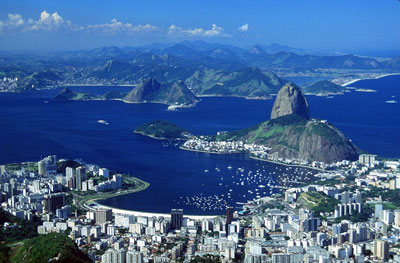 Rio is a city of many contrasts, light and dark, mountains and sea, poverty and wealth. They mingle together as does the light at dawn or dusk, then separate, giving glimpses of glorious beauty and extreme ugliness. One might say, 'like life' and just so, pulsing through this cosmopolitan city, with its sprawling environs, dazzling beaches and majestic mountains you can sense the exciting rhythm of its spirited people. A conglomerate of multi-ethnic, multi-cultural beings who truly believe in their way of life and give thanks daily to the Cidade Maravilhosa – the Marvellous City.
Rio is a city of many contrasts, light and dark, mountains and sea, poverty and wealth. They mingle together as does the light at dawn or dusk, then separate, giving glimpses of glorious beauty and extreme ugliness. One might say, 'like life' and just so, pulsing through this cosmopolitan city, with its sprawling environs, dazzling beaches and majestic mountains you can sense the exciting rhythm of its spirited people. A conglomerate of multi-ethnic, multi-cultural beings who truly believe in their way of life and give thanks daily to the Cidade Maravilhosa – the Marvellous City.
Founded by the Portuguese in the early 16th century, this guttural language is still spoken by its inhabitants, Of course, for visitors, translations into English are everywhere and most people have a basic understanding and are able to communicate, on one level or another.
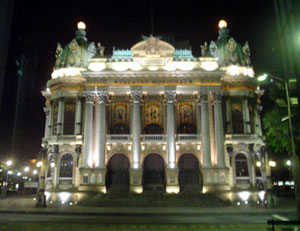 There is a multitude of interesting sites for those with intellectual leanings. The Cultural Corridor in the heart of downtown Rio includes a number of historical buildings such as the National Library built in neoclassic style where the smallest book in the world is on view. The gorgeous Municipal Theatre is modeled on the Opera Charles Garnier in Paris. It was known as Rio’s most luxurious and extravagant building and, lit up at night, 'tis a glorious sight to see, being the center of Rio's cultural activities.
There is a multitude of interesting sites for those with intellectual leanings. The Cultural Corridor in the heart of downtown Rio includes a number of historical buildings such as the National Library built in neoclassic style where the smallest book in the world is on view. The gorgeous Municipal Theatre is modeled on the Opera Charles Garnier in Paris. It was known as Rio’s most luxurious and extravagant building and, lit up at night, 'tis a glorious sight to see, being the center of Rio's cultural activities.
The Sao Bento Monastery is one of Brazil’s most historic buildings dating back to the mid 17th century. Amongst the precious artifacts are wood carvings designed by Frei Domingos da Conceicao and paintings by Ricardo do Pilar and Jose de Oliveira Rosais. The Outeiro da Gloria set atop a steep hill crowned by a lovely little church is a fascinating study for those interested in the blue and white tiling artistry of the early Portuguese. The walls in this sacred building are covered in tiling depicting scenes from the "Song of Songs".
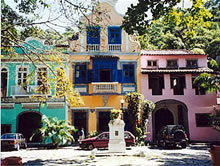 Quite enchanting are the seven colorful townhouses in the Largo do Boticario which have become a monument to the colonial aspect of the city. The little cobble-stoned street with its ancient trees and the quiet lilt of the Carioca River lazily winding through, endowed upon the city inhabitants their nickname 'cariocas'. The gracious facades of these charming buildings built in the 1800's are a reminder of an age long gone.
Quite enchanting are the seven colorful townhouses in the Largo do Boticario which have become a monument to the colonial aspect of the city. The little cobble-stoned street with its ancient trees and the quiet lilt of the Carioca River lazily winding through, endowed upon the city inhabitants their nickname 'cariocas'. The gracious facades of these charming buildings built in the 1800's are a reminder of an age long gone.
The Museu da Republica, formerly the Catete Palace, is another place of interest. It is known for its luxurious decorative style of architecture having been built between 1858 and 1867 and is representative of the ancient mansions built in Rio de Janeiro at that time. In 1808 the court of the royal Portuguese family moved to Rio and great mansions were built to house the courtiers. But with the decline of the coffee plantations and lack of slave labour, many of these changed hands and in 1896 the Catete Palace, known as the Palace of the Eagles because of the great statues on the roof, was bought to install the Presidency of the Republic.
 In 1960 the Federal Government transferred to Brasilia and since then the Museu has been a mecca for those interested in the republican history of Brazil, documented in objects, photographs and memorabilia. From the reconstruction of President Vargas' private apartments where he committed suicide to a Light and Sound show recording the life and death of this man – quite fascinating to those of a gory nature!
In 1960 the Federal Government transferred to Brasilia and since then the Museu has been a mecca for those interested in the republican history of Brazil, documented in objects, photographs and memorabilia. From the reconstruction of President Vargas' private apartments where he committed suicide to a Light and Sound show recording the life and death of this man – quite fascinating to those of a gory nature!
But Rio is not only monuments built by man for man, nature herself has been very generous to this exotic part of the world. The glorious aquamarine waters of the Southern Atlantic Ocean lap against pearly white beaches or foam whitely against the outbreaks of rock around which the Fort of Copacabana was built to defend the city against pirates. All around the undulating mountains spiked by the Corcovado and Sugar Loaf assert themselves in total grandeur.
Built between sea and mountains the city of Rio with its population of 6 million stretches out to a 300 mile radius and every day, come rain or shine, the beaches are crowded with people walking, running, building picturesque sand castles, playing volleyball, surfing or just idling at open air stands to drink the famous coconut milk. And over all the great statue of Christ the Redeemer munificently places his blessing, his arms outstretched seemingly encompassing the world in his love.
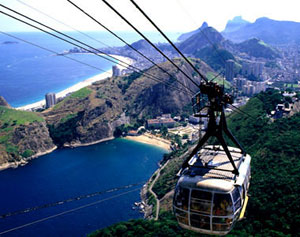 To reach the Corcovado (corcova means hunchback and describes the shape of the mountain) is 20 minute by bus from the center of Copacabana. The ride on the railway through the incredible Tijuca Forest, the largest urban forest in the world and situate in the ecological heart of Brazil, takes 17 minutes to the top where the awesome Christ statue soars 125 feet into the sky. From this vantage point, an incredible panorama of Rio is laid out. The beautiful harbors, luxuriant forests and white candy floss hotels, side by side like soldiers marching endlessly along the white stretches of beach, and above shines the brilliant blue sky. The cable car is the only transportation to the top to visit the famous Sugar Loaf mountain named because of its similar shape to an old cone of sugar (the name comes from the Tupi Indians' Pau-nh-Acuqua which translates to "high hill, pointed and isolated"). There are two stages, the second one transporting visitors to the summit and, once again, the vastness and beauty of Rio is spread below. For those who fear heights and being transported across vast empty spaces in a small glass box, I recommend you take your courage in your hands (as I did mine) and do it, especially as the cable car system has never had any accidents since its inception 1912.
To reach the Corcovado (corcova means hunchback and describes the shape of the mountain) is 20 minute by bus from the center of Copacabana. The ride on the railway through the incredible Tijuca Forest, the largest urban forest in the world and situate in the ecological heart of Brazil, takes 17 minutes to the top where the awesome Christ statue soars 125 feet into the sky. From this vantage point, an incredible panorama of Rio is laid out. The beautiful harbors, luxuriant forests and white candy floss hotels, side by side like soldiers marching endlessly along the white stretches of beach, and above shines the brilliant blue sky. The cable car is the only transportation to the top to visit the famous Sugar Loaf mountain named because of its similar shape to an old cone of sugar (the name comes from the Tupi Indians' Pau-nh-Acuqua which translates to "high hill, pointed and isolated"). There are two stages, the second one transporting visitors to the summit and, once again, the vastness and beauty of Rio is spread below. For those who fear heights and being transported across vast empty spaces in a small glass box, I recommend you take your courage in your hands (as I did mine) and do it, especially as the cable car system has never had any accidents since its inception 1912.
Of course Rio does not live on sight alone, music is definitely part of the culture, be it for listening or dancing. The Samba, the romantic charo and pagode sing-along samba are all musical expressions unique to Rio, birthplace to samba which later became Bossa Nova, supposedly influenced by the "sweet swing of the sea", and, of course, the Girl from Ipanema. But no one can ever take the place of Carmen Miranda, Rio's greatest ambassador of song and dance. Dedicated to her is the Carmen Miranda Museum where many of her outrageous costumes, headdresses, jewellery and, most extravagant of all, her platform-heeled shoes can be viewed.
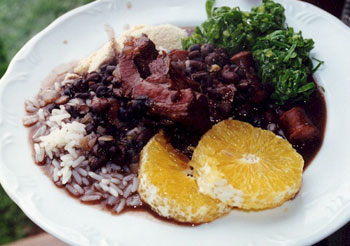 The cuisine of Brazil is diversified in its ethnicity. Italian food has gained a certain footing especially the Cipriani Restaurant in the famous Copacabana Hotel home to many dignitaries and actors from the star studded skies of Hollywood and other points on the planet where such type people evolve. Rio's contribution to the national cuisine is 'feijoada' which is based on beans, a staple item in all Brazilian diet.
The cuisine of Brazil is diversified in its ethnicity. Italian food has gained a certain footing especially the Cipriani Restaurant in the famous Copacabana Hotel home to many dignitaries and actors from the star studded skies of Hollywood and other points on the planet where such type people evolve. Rio's contribution to the national cuisine is 'feijoada' which is based on beans, a staple item in all Brazilian diet.
The ingredients of 'feijoada' a type of stew include dried meats, salt pork, ribs, various types of sausages and other parts of pig. It is served with white rice, farofa (fried marioc flour), kale, sliced oranges and hot pepper sauce. The Casa da Feijoada in Ipanema is known for this famous dish.
Rio is a high energy city with high-energy cuisine. Fresh seafood, lavish salad bars, lots of beef and juice bars where exotic tropical fruits are mingled and crushed. Barbecue restaurants known as Churrascaria such as 'Marius' in Ipanema often serving over 20 kinds of meat including beef ribs, spare ribs, pork and lamb chops, filet mignon, picanha with garlic, goat, chicken, turkey breast and breast of steer for an all-you-can eat price. These meats appear tableside to be carved onto diner's plates.
 Drinks to be tried are the 'Batida' made from cachaca, being alcohol distilled from sugarcane, and mixed with fresh-squeezed juices, the 'Caipirinha’ which is cachaca, sugar and limes on ice and the most popular drink in Rio. The Chopinhos or chopp are lager draft beers very popular with natives and visitors alike.
Drinks to be tried are the 'Batida' made from cachaca, being alcohol distilled from sugarcane, and mixed with fresh-squeezed juices, the 'Caipirinha’ which is cachaca, sugar and limes on ice and the most popular drink in Rio. The Chopinhos or chopp are lager draft beers very popular with natives and visitors alike.
Brazil is a paradise for vegetation, the climate lending itself so well to growth. Brazilians say that God must have been a Brazilian because of the natural beauty that abounds. Plants with curative powers are found in the Rain Forests although with the terrible demolition going on, many of these are being lost forever.
In Rio a fascinating outing is to the Botanical Gardens, a paradise of plants and trees from the four corners of the world. It spreads over 340 acres and contains nearly 5,000 different species of plants including the Imperial Palms planted in 1842 just after the arrival of the Portuguese Court in 1808. If you look carefully, you may happen upon a faded banana-yellow portico leading to a rather dilapidated pool into which a lovely marble statue, completely oblivious to the comings and goings of mere mortals, endlessly pours her libation. The aged blue and white tiles, sparkling water dotted with ivory white lilies and the symmetry of line make this an incredible sight for those who see beyond the norm.
A very important consideration to travelers is where to stay on these sojourns from home. Considerations such as money probably ranking amongst the highest, comfort and service a close second. But you can choose from over 264 hotels offering every type of room and service from the meagerest hostel to the luxurious Copacabana Palace, knowing full well that near to any one are the glorious beaches – Copacabana, Ipanema, Leblon, Sao Conrado, Barra da Tujuca strung like pearls along the startling blue waters of the Atlantic Ocean.
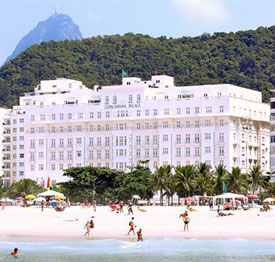 To relive the glamour of the 40's when Rio was experiencing its heydey in Hollywood musicals, the Copacabana Palace Hotel is the place to stay. Then the stage and focal point for the biggest, most glamorous and important events in Rio, both culturally and politically. Today, after a 40 million dollar renovation, the romance and elegant ambiance is alive and well. Bedrooms and suites are lavishly decorated and offer every service and comfort. Restaurants prepare local and international cuisine and the intimate cocktail lounge is a grand place to while away the evenings. There is a magnificent semi-Olympic swimming pool, health club and beauty shop, and the hotel is equipped to handle everything from a small company meeting to a major international conference.
To relive the glamour of the 40's when Rio was experiencing its heydey in Hollywood musicals, the Copacabana Palace Hotel is the place to stay. Then the stage and focal point for the biggest, most glamorous and important events in Rio, both culturally and politically. Today, after a 40 million dollar renovation, the romance and elegant ambiance is alive and well. Bedrooms and suites are lavishly decorated and offer every service and comfort. Restaurants prepare local and international cuisine and the intimate cocktail lounge is a grand place to while away the evenings. There is a magnificent semi-Olympic swimming pool, health club and beauty shop, and the hotel is equipped to handle everything from a small company meeting to a major international conference.
Of course the perfect time to visit is Carnival time. Carnival in Rio with its street carnivals, masked balls, colourful costumes, throbbing samba concerts, flamboyant bands and exotic samba schools set against a background of unbridled sensuality and throbbing music.
It’s all yours from morning to night, glorious, glamorous Rio de Janeiro, all you have to do is Do It.